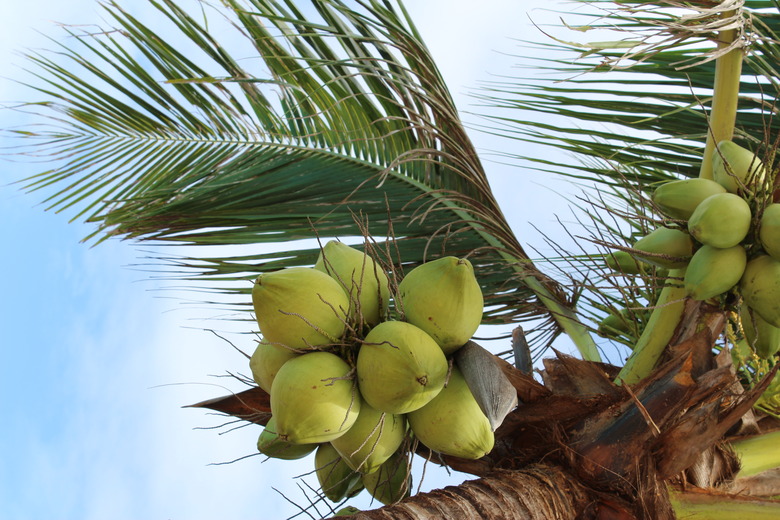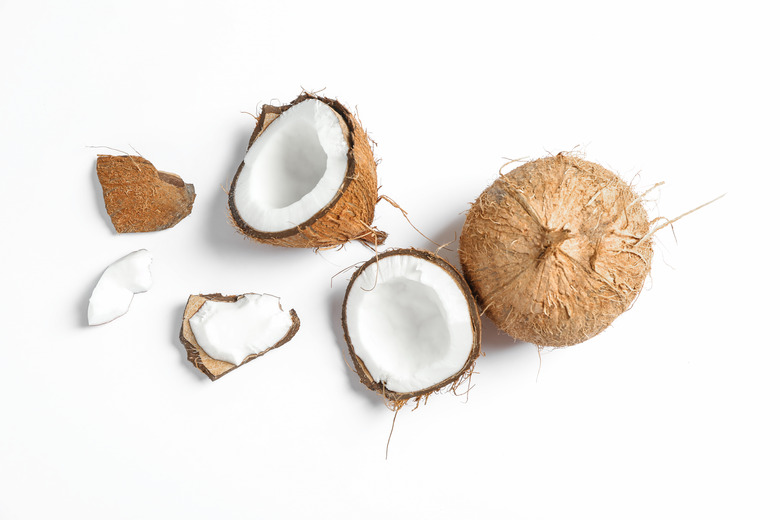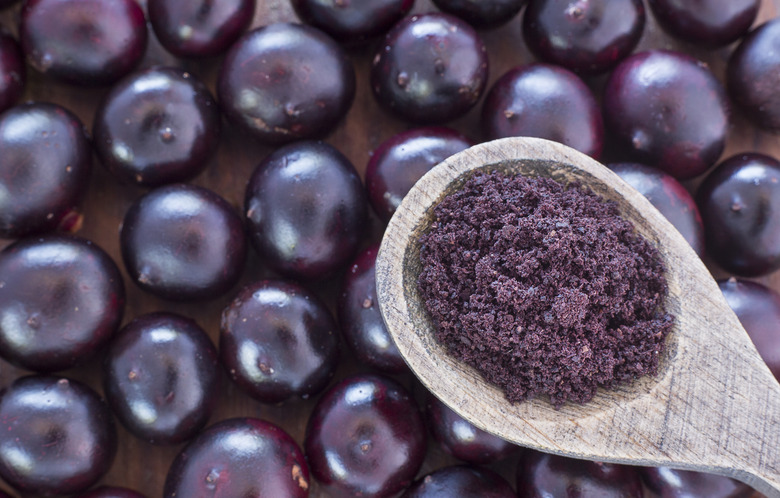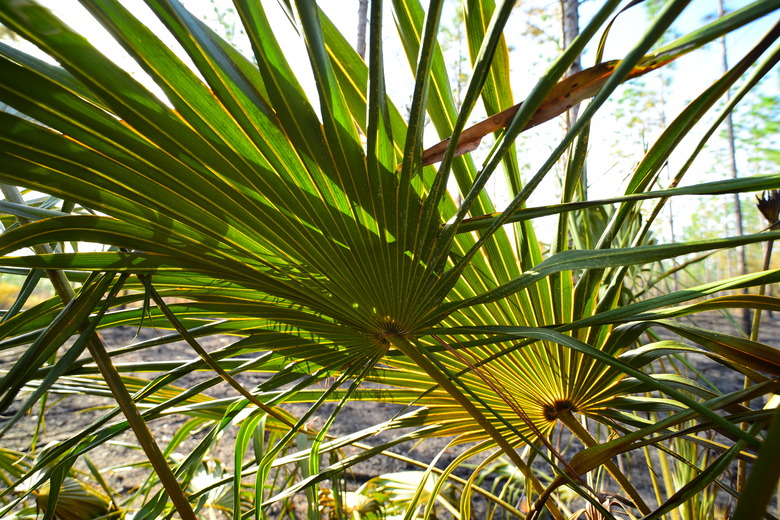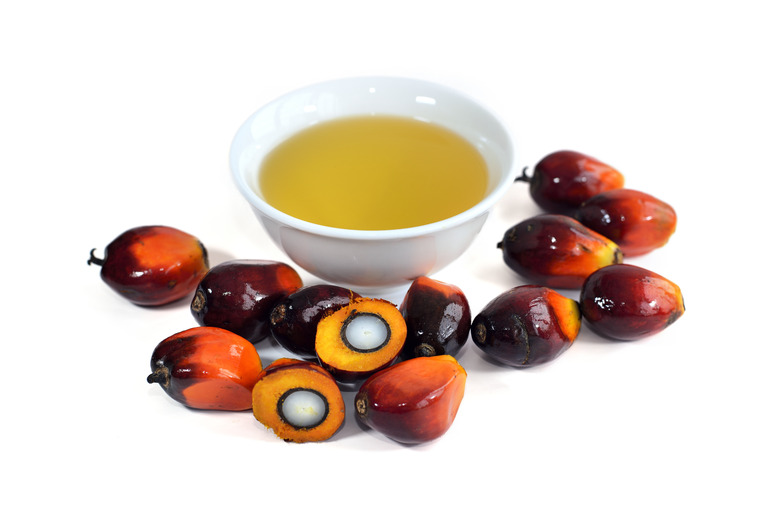What Fruit Grows On Palm Trees?
The term palm tree can generically refer to any of the tropical tree species with long, straight trunks with large leaves at the top. More technically, a palm tree refers to a number of plants within several genera of the Areccacae family of plants. This family includes a good many shrubby species, but those that take the familiar tree-like form are generally called palm trees. There are more than 2500 species of palm trees falling into dozens of different genera. Some of these trees produce edible fruit, sometimes in such profusion that they have become very important agricultural crops. The most common fruit-producing palm trees include:
- Date palms (Phoenix dactylifera)
- Coconut palms (Cocos nucifera)
- Acai palm (Euterpe oleracea)
- Jelly, pindo or wine palm (Butia capitata)
- Peach palm (Bactris gasipaes)
- Saw palm or palmetto (Serenoa repens, Serenoa sabulata)
- African oil palm (Elaeis guineensis)
The fruit from palms is nearly as varied as the assortment in a bowl of fruit salad. From dates to coconuts and even acai berries, palm trees offer a veritable smorgasbord of edible and otherwise useful fruits.
Coconut Palm: A Classic
Coconut Palm: A Classic
Depending on who classifies them, coconuts—one of the best-known of palm fruits— can be regarded as fruits, nuts, or seeds. As it grows on a palm tree, a coconut has three layers. The outermost smooth layer, as well as a middle fibrous layer, are removed from most coconuts sold in stores. What remains is the endocarp layer: the roundish dark brown, fibrous substance that contains the coconut meat.
When a coconut is immature, the inner area is green and contains coconut water. As the coconut matures, that watery substance turns into the white coconut "meat" found inside a brown coconut. In most cases, it's a mature coconut that is sold in stores, unless the coconut is sold specifically as a means of obtaining fresh coconut water.
Ready for a Date?
Ready for a Date?
Varieties of the Phoenix dactylifera palm produce the most common varieties of edible dates, such as the medjool. Even ornamental date palms such as the zahidi, planted primarily for their stunning looks, offer edible fruits. These dates are both tasty and seedless, although some people who grow the trees for ornamental use view the fruits as a nuisance once they drop to the ground. Unlike the dried dark brown dates sold in a store, ripe dates are a bright golden yellow, crunchy and sweet.
Only the female date palm produces dates, and only if the date flowers are fertilized by pollen of male date flowers. This happens thanks to pollinating insects, such as bees and wasps, but also by the wind. If there is no male date palm nearby, growers sometimes purchase male date flowers or pollen to manually fertilize the female plant.
Acai, Full of Antioxidants
Acai, Full of Antioxidants
Acai berries, touted as a superfruit thanks to their antioxidants and beneficial nutrients, do not grow on shrubs, as many berries do. These are actually fruits of the acai palm (Euterpe oleracea), a plant native to subtropic regions. This tree gets quite tall, producing acai berries after several years. Smaller offshoots produced during this time will also bear fruit. Acai berries turn purple when ripe and look a lot like blueberries.
The Multi-Named Jelly Palm
The Multi-Named Jelly Palm
The jelly, pindo or wine palm (Butia capitata) produces fruit that's edible, tart and sweet, and often used for making jellies and wines. It's native to Brazil and the relatively dry climates of South America, but it is also used as a landscaping plant in parts of California, as well as in Atlantic and Gulf areas in the southeastern United States. The trees are relatively short, with the clusters of fruit reachable without a ladder. The yellow fruit grows in clusters, much like large bunches of grapes. Eaten raw, the fruit is fibrous, so some people chew the fruit for its juice and discard the remaining fibrous material.
Peach Palm: Nutritional Powerhouse
Peach Palm: Nutritional Powerhouse
Not an actual peach, the fruit of the peach palm (Bactris gasipaes) is often cooked because it tastes a bitter even when ripe. The fruit is similar to a date in size and turns yellow or red when ripe, depending upon the variety. The peach-palm fruit is a valuable food source in some parts of South and Central America, packed with carbohydrates, dietary fiber and a number of vitamins including, A, B, C and E.
Saw Palmetto Palm Fruit
Saw Palmetto Palm Fruit
Saw palmetto, a supplement that's fairly common health food stores, comes from fruit of the saw palm or palmetto (serenoa repens, serenoa sabulata) tree. Saw palms are native to Florida, but thrive in other areas that do not dip below 20 degrees Fahrenheit, as well. Native Americans once used the berries as both a source of food and medicine, while early settlers also ate them to prevent starvation. When the berries are ripe, they are dark blue to almost black, emitting a sweet aroma. The berries are usually tart and even bitter, not sweet. As a male health-boosting supplement, the berries are usually dried for use in teas and tinctures or powdered and put into capsules.
Betel Nut Blues
Betel Nut Blues
The areca palm produces a fruit that's used as a stimulant and health booster in parts of Asia. The areca's fruit, also known as betel nut, has been used for thousands of years for everything from boosting energy and alertness to treating indigestion. The downside: In some countries, it's used in a chewable mixture that contains tobacco and slaked lime. Chewing this betel "quid" is ingrained in the culture of male laborers, much like drinking coffee is used as a stimulant in much of the Western world. The quid mixture is linked to oral cancer in nearly epidemic proportions in Taiwan. In the United States, areca palm varieties are used as ornamental plants or even potted plants displayed indoors or on patios. As a houseplant, it's known for cleaning indoor air and grows up to 5 feet tall when planted in a 14-inch pot.
Palm Oil Popularity
Palm Oil Popularity
Palm oil, used in everything from packaged breads to biodiesel fuel, also comes from palm tree fruit. In this case, the palm tree variety is Elaeis guineensis or the African oil palm. Crude palm oil comes from the fruit itself, while palm kernel oil comes from the pit inside the fruit. Palm oil is perhaps one of the most common ingredients in packaged products and provides more than 1/3 of the vegetable-based oils used on the entire planet. The problem is the manner in which it's harvested in many areas, harming the habitats of animals such as rhinos and the orangutan. Organizations that enforce sustainable harvesting methods work to ensure that this oil is harvested using means that are less impactful on the environment.
References
- Library of Congress: Is Coconut a Fruit, Nut or Seed?
- The Merwin Conservancy: 10 Common Edible Palm Fruits
- Eat the Weeds: Jelly Palm, Pindo's Alter Ego
- Do It Yourself: Growing Acai Berries
- Mountain Rose Herbs: Saw Palmetto Berries
- Organic Facts: Seven Benefits of Peach Palm
- BBC: Asia's Deadly Secret: The Scourge of the Betel Nut
- Drugs.com: Betel Nut
- Plantz: Areca Palm
- WWF: Eight Things to Know About Palm Oil
